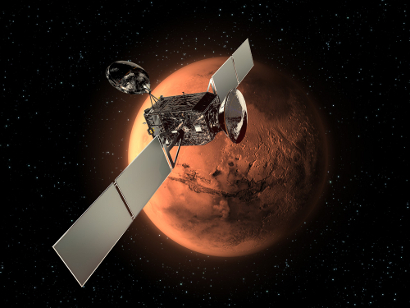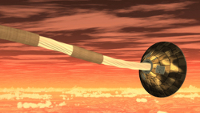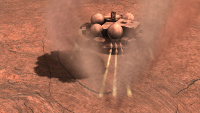Inside ExoMars - Quarterly Newsletter
Issue 2 - January 2011
| What’s new for this quarter: | |
| - |
The ExoMars programme has passed its System Preliminary Design Review, paving the way for the start of the implementation phase.
|
| - |
The Announcement of Opportunity for ExoMars Entry, Descent and Landing Demonstrator Module Science has been issued.
|
Vote of Confidence
The end of last year was marked by the successful System Preliminary Design Review, paving the way for the start, in April 2011, of the implementation phase for ExoMars. The successful completion of this review highlights the remarkable progress within the twelve months since the ESA Council gave the green light to the ExoMars programme. During this time, a series of milestones have been passed, including the selection of the instrument payload for the Orbiter and the Announcement of Opportunity for the Entry, Descent and Landing Demonstrator Module science.
For the analysis and assessment of the current design of the two ExoMars missions (to be launched in 2016 and 2018), technical experts from ESA, NASA and CNES space agencies, along with independent experts, convened at the European Space Research and Technology Centre (ESTEC). At the final meeting of this review process, held on 13 December 2010, the review board expressed its confidence in the system design.
What’s next in ExoMars?
The proposal for the upcoming implementation phase is already in preparation by the European industrial consortium and is planned to be delivered to ESA this February. This proposal will be based on the documentation delivered for the last review and the amendments that have been introduced as a result of the Review Board's conclusions. Following ESA’s evaluation and successful negotiation of the proposal, the contract for the next phases (Phase C/D – manufacturing and test of mission components, and E1 – full deployment of the mission elements) will be awarded to the Prime Contractor, Thales Alenia Space- Italy.
In the meantime, discussions with NASA on the future architecture of the 2018 mission are ongoing. NASA’s Jet Propulsion Laboratory (JPL) has published an architecture review for the 2018 mission which considers two principal approaches. The first approach, which has been the basis of discussion in the international cooperation to this point, is to land the two Rovers – ESA's ExoMars Rover and NASA's MAX-C Rover - individually. The second approach, which is to land a single vehicle and separate the two Rovers after landing, maximises the use of designs of NASA’s Mars Science Laboratory, to be launched this November, but may require ESA to adapt significantly to the new architecture.
|
|
 |
|
|
ExoMars 2016 Mission - Trace Gas Orbiter and Entry, Descent and Landing Demonstrator Module. |
EDM in progress
The EDM - a technology demonstration vehicle carried by the ExoMars Trace Gas Orbiter- will be launched in 2016 to demonstrate the capability of European industry to perform a controlled landing on the surface of Mars. Although designed to demonstrate entry, descent and landing technologies, the EDM also offers limited, but useful, science capabilities.
In November, an Announcement of Opportunity for possible science instrumentation to be included on the lander and associated science investigations has been released. All related documentation and submission forms can be accessed online. The deadline for the receipt of proposals is 1 March 2011.
Stay tuned for the upcoming animation featuring one aspect of the ExoMars 2016 mission. ESA takes a look at the entry, descent and landing steps of the ExoMars demonstrator module on Mars.
 |
 |
|
The ExoMars Entry, Descent and Landing Demonstrator Module in the entry (left) and landing (right) phases. |
|
New instruments cast their eyes to Mars
The design of the ExoMars Trace Gas Orbiter instruments, part of the 2016 mission, has been kicked off in the last quarter of 2010. The five instruments carried by the ExoMars Orbiter will investigate atmospheric gases of biological and geological importance on Mars. JPL will manage the development of the two cameras, HiSCI and MAGIE as well as the infrared spectrometer MATMOS and the infrared radiometer EMCS. ESA will monitor the development of NOMAD, a Belgian-led instrument, which combines three spectrometers covering a wide range of wavelengths (infrared, ultraviolet and visible) in order to identify the components of the Martian atmosphere and map their location.
|
Save the Date |
|
|
7-9 February Marrakech, Morocco |
Geobiology in Space Exploration
|
|
8-11 February Paris, France |
4th International Workshop on the Mars Atmosphere: modelling and observations
|
|
3-8 April Vienna, Austria |
European Geosciences Union - General Assembly 2011
|
|
18-20 May Madrid, Spain |
Conference on the Micro-Raman and Luminescence in Earth and Space Sciences
|
|
13-15 June Portugal |
Exploring Mars Habitability
|
|
16-17 June Portugal |
1st International Mars Exploration Program Analysis Group (MEPAG) meeting
|
|
For more information, you can also access the complete
Events Archive |
|
|
ExoMars Timeline |
|
|
2011 |
|
| April-June |
Selection of the ExoMars 2016 Entry, Descent and Landing Demonstrator Module payload
|
| April | Implementation Phase (phase C/D) kick off |
| February |
Financial proposal for the next phases of the programme (C/D/E1) to be received by ESA
|
|
2010 |
|
| December | System Preliminary Design Review - completed |
| November |
Release of Announcement of Opportunity for ExoMars Entry, Descent and Landing Demonstrator Module Science
|
| October | System Preliminary Design Review (SPDR) - kick off |
|
Industrial negotiations for the present phase of the programme (B2X2 - design phase) have been completed
|
|
|
For more information, you can also access the complete ExoMars timeline
Disclaimer: Future milestones are indicative and subject to change
|
|
Stay informed about the ExoMars activities by subscribing to this service.
| ESA – ExoMars Programme | Don McCoy |
RoboticExploration esa.int esa.int |
ExoMars Project Manager |
